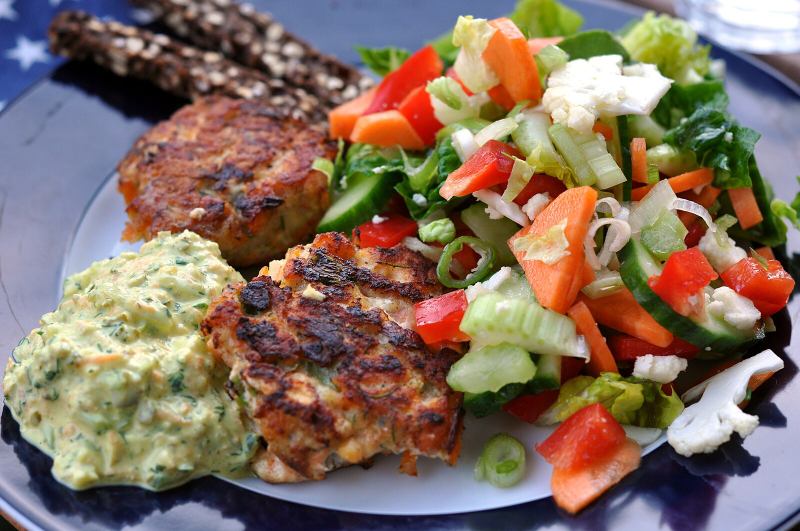What do they eat in Denmark? Expect plenty of meat, potatoes, and some flavors that might surprise the unprepared. Traditional Danish cuisine is heavy on hearty meats, with pork taking the spotlight. Pigs outnumber people in Denmark six to one, after all. Dishes like stegtflæsk med persillesovs, a thick cut of fried pork belly served with parsley sauce, are national favorites.
For a twist, some Danes skip the parsley sauce in favor of a sweet apple compote. Danes also enjoy classics like frikadeller (savory meatballs of veal and pork mixed with onions and flour), smørrebrød (open-faced sandwiches topped with meats, fish, and rich sauces on dark rye bread), and, yes, plenty of licorice. That’s not all there is to Danish cuisine, though. To learn more about what the Danes like to eat, keep reading.
What Do They Eat in Denmark for Breakfast?
In Denmark, breakfast is typically a simple affair, centered around bread and dairy. A classic start includes rundstykker, or morning rolls, often topped with butter, cheese, jam, or thin slices of chocolate. For those who like variety, these rolls come with or without poppy seeds—poppy seed rolls being a particular favorite.
Danish pastries, or wienerbrød may also appear, but usually only on weekends or special occasions.
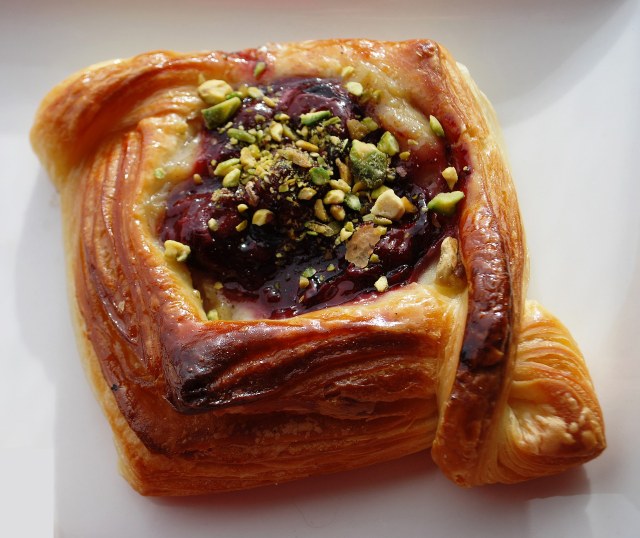
While eggs and bacon aren’t common for Danish breakfasts, some Danes still enjoy a bowl of cold oatmeal (havregyrn), yogurt, or even a bit of fruit.
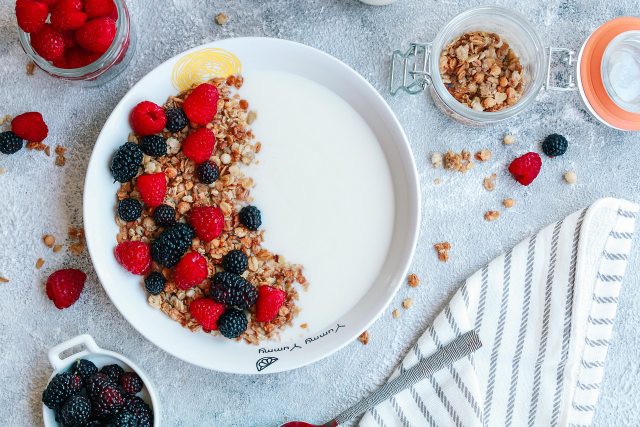
For some, a cup of coffee is sufficient.
Top Danish Dishes to Try
Smørrebrød
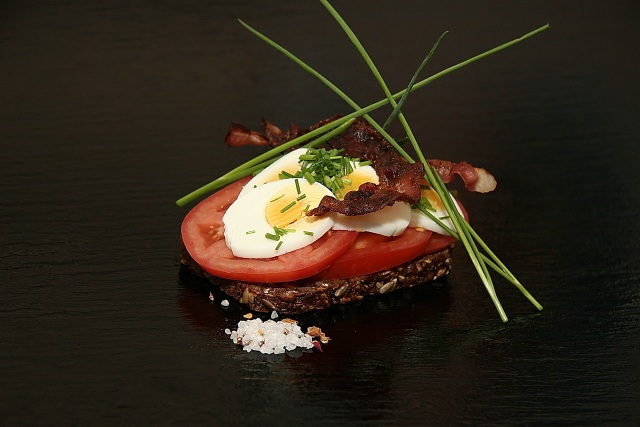
Smørrebrød is a Danish open-faced sandwich that takes a single, thin slice of rugbrød (dark rye bread) and layers it with toppings, covering every inch.
The bread itself is small, often just slightly larger than a stamp, and generously buttered with “toothbutter,” a thick enough layer to leave tooth marks.
Toppings can range from simple cold cuts to elaborate arrangements with smoked salmon, shrimp, or eel. A popular version is Stjerneskud (Shooting Star), topped with lettuce, mayo, peeled shrimp, a fried filet of plaice, and a dollop of lumpfish roe.
The secret to smørrebrød is in the careful decoration. Garnishes are often added to enhance the main topping. For instance, orange slices are paired with roast pork.
Danish Soups
Danish soups are hearty, containing rich ingredients that make them perfect for comfort in Denmark’s cold weather. Some popular Danish soups include kød og melboller suppe, kraasesuppe, and grönkaal.
Kød og Melboller Suppe (Meatball and Dumpling Soup)
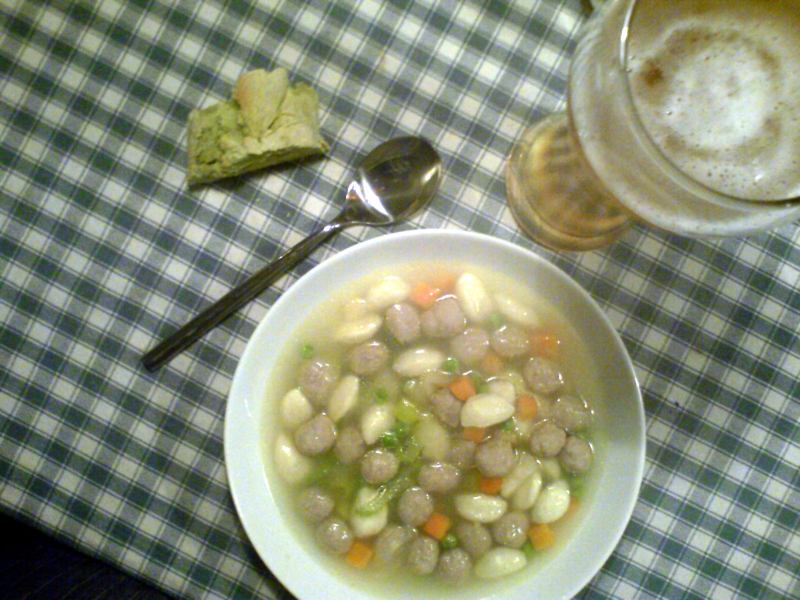
This traditional soup combines small dough and meat dumplings with a simple vegetable broth. In Denmark, the dumplings are often store-bought frozen for convenience, but they can also be made from scratch using a choux pastry dough. The soup is quick to assemble once the dumplings are prepared.
Kraasesuppe (Giblet Soup)
This Danish soup uses giblets, simmered in water with salt, then complemented by sliced carrots, celery, leeks, apples, and prunes. A touch of sugar and vinegar adds depth to the flavor, and flour dumplings are added for extra texture. Kraasesuppe carries a unique balance of savory and slightly sweet tastes.
Grönkaal (Cabbage Soup with Pork)
This hearty soup begins with pork boiled in water with carrots, leeks, parsley, and herbs, cooked for several hours. Blanched and finely chopped cabbage is gradually added to the pork stock, thickened with a sprinkle of flour. The soup is served with vegetables, potatoes browned in butter, and the pork itself.
Stegt Flæsk
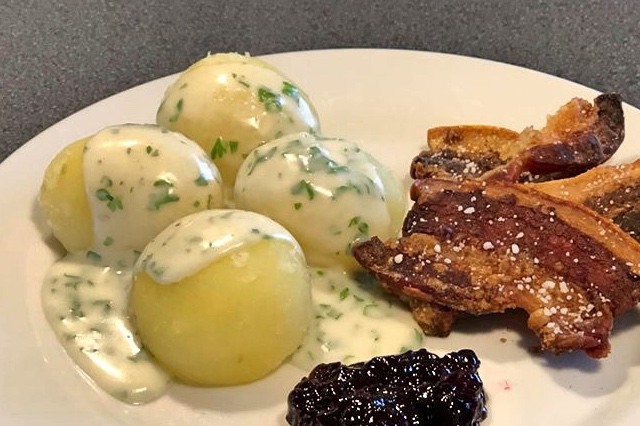
Stegt Flæsk med Persillesovs, or roast pork with parsley sauce, is one of Denmark’s most beloved dishes. This meal consists of crispy fried pork served with boiled potatoes and a creamy parsley sauce. If you want to enjoy it at home, take 20 pork slices and season them with salt. Either pan-fry them or roast them in the oven at 200°C for about 30 minutes to achieve a crispy texture.
To make the parsley sauce, melt butter, whisk in flour, and gradually add milk until smooth. Enhance the flavor with freshly chopped parsley, salt, pepper, and a dash of nutmeg.
In Denmark, this dish is often enjoyed as a comforting evening meal. It was officially named the national dish in 2014 after a public vote, winning against other Danish favorites like smørrebrød and hakkebøf.
Fiskefrikadeller
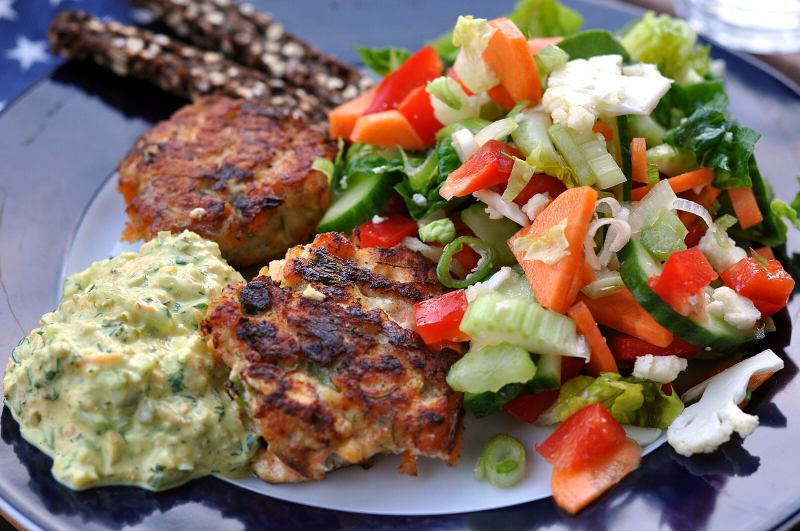
Danish Fish Cakes, or “Fiskefrikadeller,” are delicately flavored fish patties that are popular in Danish cuisine. Made with cod fillet as the primary ingredient, the fish is roughly chopped and blended with salt to retain moisture.
Grated onion, ground pepper, eggs, and potato flour are added to enhance the flavor and texture. The mixture is then processed with milk until smooth and creamy, resulting in a firm batter that is chilled before cooking.
These fish cakes are fried in a mixture of butter and oil until golden and crisp on the outside while staying moist and almost creamy inside. They are often served warm with a dill sauce, which typically includes Greek yogurt, mayonnaise, fresh dill, Dijon mustard, and dill pickle relish for a refreshing and complementary flavor.
Known for their smooth, crisp texture, Fiskefrikadeller can be enjoyed as an elegant main dish or as an appetizer, topped with a dollop of aioli and a sprig of dill.
Danish Sausages
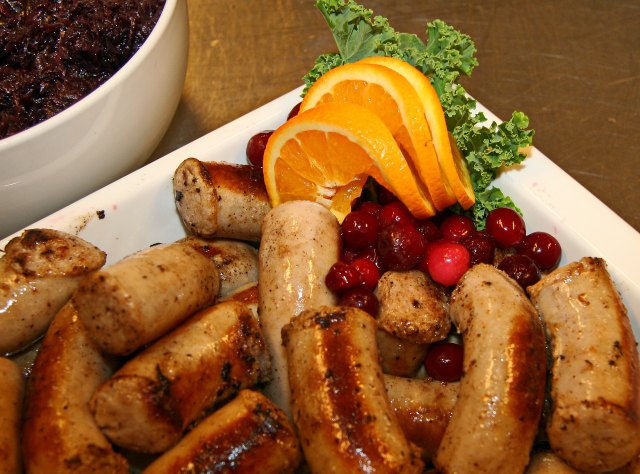
Medisterpølse is the Danish name for pork sausage. It’s sweet, sour, and savory. Medisterpølse becomes more popular in Denmark around the Christmas season, where it is often seasoned with ground cloves for a festive touch.
What does this lovely sausage contain? A blend of ground pork, pork belly, and a mixture of spices like cloves, nutmeg, allspice, and black pepper, combined with potato starch, egg whites, and cold chicken stock.
Medisterpølse is traditionally served warm on Danish rye bread with pickled red cabbage, boiled potatoes, and a rich pan-gravy.
Pickled Herring
In Denmark, you may find pickled herring served as part of a smørrebrød or enjoyed on its own. Prepared with vinegar, sugar, and various spices, pickled herring can be found in a range of flavors, from mild to spicy. Pair it with a slice of rye bread and a cold beer.
What do they Eat in Denmark for Christmas?
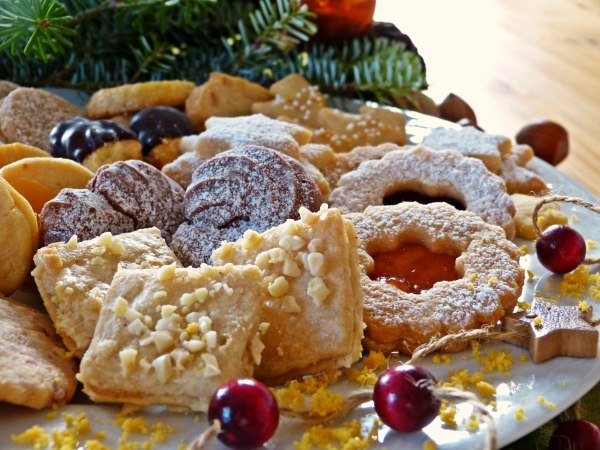
The centerpiece of a Danish Christmas dinner is often a choice of roasted duck, pork, or sometimes both. The pork, known as flæskesteg, is cooked to perfection with a crunchy, almost glass-like crust that shatters under the knife.
Each bite of the pork has that deep, savory crunch that cuts through to reveal a deliciously fatty and juicy layer of gamey meat beneath.
Danish people like to have potatoes— either classic white or caramelized in sugar to a golden brown—as sides. They also enjoy sweet and sour red cabbage, softened but still with a slight bite, delivering big, berry-like notes that contrast the meat and help balance its richness. Gravy is dark and thick, poured generously over everything.
To finish, there’s risalamande, a creamy, slightly chewy rice pudding with chopped almonds folded in, served with a sweet-tart cherry sauce. It’s sometimes warm and sometimes cold. The Danes eat it slowly to find the single whole almond hidden inside, which brings good luck and sometimes a prize.
What Do They Eat in Denmark for Easter?
Well, Easter is a time for family gatherings and festive meals. Traditional Easter foods include lamb, smoked fish, and a variety of salads and side dishes. One popular Easter treat is påskeæg, a hollow chocolate egg filled with smaller chocolates or candies.
What Do They Eat in Denmark on the Go?
Hot dogs are the most popular street food in Denmark. You’ll find pølsevogne, or sausage wagons, throughout the country, serving up delicious hot dogs with a variety of toppings. Danish people also eat fish patties or fish cakes and smørrebrød on the go.
What Do They Eat in Denmark for Dessert?
Popular Danish desserts include the following:
- Koldskål (“cold bowl”): This is a summer treat made with buttermilk, lemon, vanilla, sugar, and eggs, whisked together. It’s served in a bowl with Kammerjunker cookies sprinkled on top.
- Rødgrød med Fløde (“red pudding with cream”): This dessert consists of boiled strawberries and rhubarb sweetened and reduced to a purée, then chilled. It’s served with milk or cream poured over.
- Æbleskiver (“apple slices”): Despite the name, these spherical, light pancakes contain no apples. They’re a traditional Christmas delicacy, served with raspberry, strawberry, or blackberry jam and sprinkled with powdered sugar.
- Cinnamon rolls: Danish cinnamon rolls are made with a dough similar to croissant dough, resulting in a flaky and light pastry full of flavor.
- Drømmekage (dream cake): It’s aDanish sponge cake known for its delicious caramelized coconut topping. It gained popularity in the 1960s after a 13-year-old girl won a cooking competition with her grandmother’s recipe.
- Wienerbrød (“Viennese bread”): Meet the pastry made from yeast-leavened dough folded 27 times, available in various sizes and fillings like cream or jam.
- Vaniljekranse: These are vanilla-flavored butter cookies popular during Christmas. They’re often found in Royal Dansk blue tins and make common Christmas presents or souvenir gifts.
What Do They Eat in Denmark as Vegetarians and Vegans?
Like we stated above, traditional Danish Cuisine is meat-heavy. However, most Danish supermarkets offer a good selection of fruits and vegetables, including organic options. In larger cities, they also carry specific vegan and vegetarian products such as bean paste.
Asian markets in these urban areas also provide a variety of spices. The translation of everything we just said is that if you want to survive as a vegetarian or vegan in Denmark, you need to cook your own meals.
What Do They Eat in Denmark? Conclusion
Danish food is flavorful and delicious. If you have access to the ingredients in your country, try preparing any of the Danish meals that catch your fancy. But if you’re in Denmark, it’s a good idea to learn how to cook the local delicacies yourself. The food sold in restaurants is quite pricey and can drill a deep hole in your pocket quickly.
